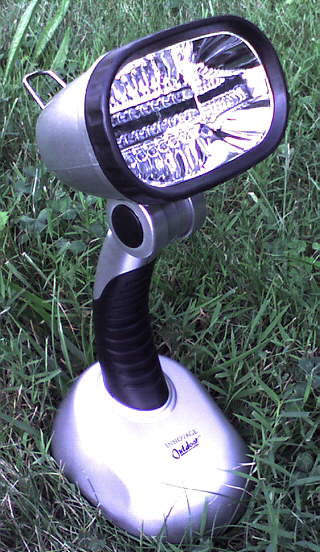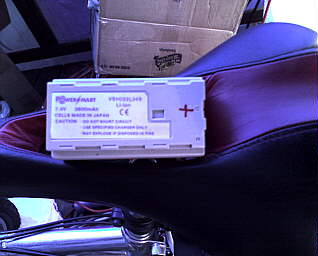K3PGP.Experimenter's.Corner
![]()
K3PGP.Experimenter's.Corner
![]()
Home Astronomy Bicycle Construction Laser Moonbounce Software Guest Misc Sales
Bicycle
Headlights, Turn Signals, Brake Lights
And a HORN
! (From a 12 volt scooter)
|
!!! TURN SIGNALS !!! I am currently reviewing and testing several different brake light / turn signal systems for bicycles. So far I have less than $20 in this project! A short video of phase 1 of this project is here > Turn Signal Video 1 The two 1.5 AA batteries were removed from the unit under the seat and the space used for 3.3 and 5.0 vdc regulators plus three SPST DIP relays. The output of the relays control the additonal lights. The relays turned out to be a much better choice (and cheaper!) than opto couplers, buffers and transistors! The entire system now runs off a 12 volt Li-Ion recharable battery which also powers the video system. Rear lights are now installed > Turn Signal Video 2 Next is front turn signals and white LED headlights! More info to follow... |
| Here is a closeup of the bicycle safety lighting
system mounted under the seat. This system runs off two AA flashlight batteries as it comes from the factory. It was considerably cheaper (and easier!) to purchase this system and modify it compared to building everything from scratch. |
|
| I mounted the interface to the external LED lights in
the space where the two AA flashlight batteries used to
live. The unit is now powered from a 3.3 volt regulator off the 12 to 16 main battery system on the bicycle. There is not enough detail in this photo to see the 3.3 and 5.0 volt regulators and three DIP relays that control the external LED cluster lights. Video showing the FRONT of the bicycle > Headlights Video showing the REAR of the bicycle > Turn Signal Video 2 |
|
 |
!!! HEADLIGHTS !!! < Looks like a great start on a bicycle headlight! I got two of them for $20. There are 20 white LEDs in each for a total of 40 LEDs. Although originally designed for 4.5 VDC @ 300 ma with all LEDs lit, preliminary tests indicate it will be very easy to modify these to run on the existing 12 to 16 VDC bicycle battery system. Only the top part of the flashlight is used and after some internal modifications, two of them in SERIES pull around 175 ma @ 16 VDC which is what I get when the batteries are fully charged. Even after a couple of weeks of powering the video system I am still getting very near 16 VDC. I have been running the parking, brake and turn signal lights as well as the video system during daylight hours and battery life has NOT been a problem so far. I only need to recharge the batteries once a month or so which translates to about 300 miles! We'll see how the battery system holds up with the additional load and the coming colder weather. At 175 ma @ 16 VDC, two of these headlights are brighter than any bicycle light I've seen so far. In fact I may be able to dim them down a bit (less current = longer battery life). 175 ma is not much of a load on the Li-Ion batteries which are rated at 3800 mAh (3.8 AMP hour) so I may leave well enough alone unless I get complaints about them being too bright! Now that would be a switch for a bicycle headlight now wouldn't it? When this project is completed the bicycle will have a total of 180 LEDs! 20 in each turn signal (front and rear = 80 total), 60 in the brake tailight, and 40 in the headlights. NOTE: Running the headlights in SERIES is MUCH more efficient than running them in parallel. Two in parallel would pull twice as much current (~350 ma) with half the power being dissipated as heat in the dropping resistors! This is why I am using using two of them rather than one as using only one headlight would have the same issue. Two in series is simply a better match for the existing power system I already have on the bicycle. |
 |
Short video showing ONE
headlight (NOT mounted) and the front turn signals. >
Headlight UPDATE: Two headlights now mounted > Headlights |
| A quick test of the headlights
at night > Lights
at Night You will see the headlights appear to become brighter as I get them aimed properly. This video was shot with a night vision video camera sitting on the saddle. It goes into long shutter mode (low frame rate) under reduced lighting conditions which is what causes the blurring with movement. As you can see these are brighter than most bicycle lights and the amazing thing is they are only pulling 175 ma from the battery system which is 2.1 watts. They were designed to be used as a flashlight. There are 20 LEDS in each one and they are easily modified to run on 12 to 16 vdc. More info to follow... |
|
 |
!!! BATTERIES !!! < PowerMart VSH022S 7.4v 3800 mAh battery that is working well for me. These are normally used to power Sharp VL-NZ50 and VL-NZ100 camcorders. I have seen them NEW on Ebay for less than $15! (But also as much as $40 each! You don't want to know what they cost from Sharp!) I am using TWO of them in series. One is shown here sitting on the saddle for size comparison. They are extremely light and small for the amount of power they produce. NOTE: If you need to power something rated at 12 VDC you may need to do something to drop the voltage a bit. Although the batteries are rated at 7.4v I get a bit over 16 volts out of two of them in series. SOME items will tolerate the higher voltage with no problem. But many items will NOT !!! I have now put around 30 hours of runtime on these batteries using the new lighting system with EVERYTHING turned on including the headlights and the voltage is still above 16 volts! The old video camera used to draw more current from these batteries than what the entire system now draws including the lights and I used to go about a month (300 miles) before needing to recharge. I'll know more about how often they will need recharged after I run the system for a few months. |
Home Astronomy Bicycle Construction Laser Moonbounce Software Guest Misc Sales
Contents of this website are ©1997 - 2014 of K3PGP and of the originating authors.